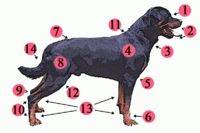
Photo from wikipedia
Background Patellofemoral pain is one of the most common forms of knee arthralgia in adolescent females. Unlike in adults, in whom the etiology of patellofemoral pain is considered to be… Click to show full abstract
Background Patellofemoral pain is one of the most common forms of knee arthralgia in adolescent females. Unlike in adults, in whom the etiology of patellofemoral pain is considered to be multifactorial (eg, altered bone shape and musculoskeletal dynamics), the etiology of adolescent patellofemoral pain has been historically attributed to overuse. Although it is highly plausible that adolescent patellofemoral pain results from excessive maltracking, as suggested by recent research, an increase in patellar, relative to femoral, size could also contribute to patellofemoral pain through altered cartilage stresses/strains, resulting in overloading of the subchondral bone. Because the role of bone morphology in the genesis of patellofemoral pain in adolescent females remains largely unknown, research is needed in this area to improve our understanding of patellofemoral pain and advance diagnosis/treatment. Questions/purposes (1) Are patellar volume and width increased, and femoral trochlear width decreased, in female adolescents with patellofemoral pain compared with asymptomatic females? (2) Are measures of patellofemoral size correlated with patellofemoral tracking? Methods Twenty adolescent females with patellofemoral pain (age, 13.7 ± 1.3 years) and 20 asymptomatic female control participants (age, 13.6 ± 1.3 years) were enrolled in this case-control institutional review board-approved study. This study focused on a strict definition of patellofemoral pain, peripatellar pain in the absence of other structural pathologic conditions (eg, tendinitis, ligament injury, Osgood-Schlatter disease) or a history of dislocations/trauma. Control participants with no history of patellofemoral pain or other lower extremity pathology were matched for age (within 6 months) and body mass index (within 5 kg/m2). Participants self-referred and were recruited through clinicaltrails.gov, printed advertisements, and word of mouth. Three-dimensional (3-D), static, T1-weighted, gradient recalled echo MR images were acquired, from which 3-D patellofemoral models were created. Patellar volume and width, patellar-to-femoral volume and width ratios, and femoral trochlear width were compared across cohorts. In addition, 3-D patellofemoral tracking was quantified from dynamic MR images captured during cyclical flexion-extension volitional movements of the lower extremity. The size measures and ratios were correlated to patellofemoral tracking. Results Compared with control participants, the cohort with patellofemoral pain had greater patellar volume (13,792 ± 2256 versus 11,930 ± 1902 mm3; 95% confidence interval [CI], 1336 mm3; p = 0.004; d = 0.89) and width (38.4 ± 3.0 versus 36.5 ± 2.7 mm; 95% CI, 1.8 mm; p = 0.021; d = 0.67). The femoral trochlear width was smaller (32.0 ± 1.8 versus 32.9 ± 1.8 mm; p = 0.043, d = 0.54). The patellar-to-femoral volume ratio and the patellar-to-trochlear width ratio were greater in adolescents with patellofemoral pain (0.15 ± 0.02 versus 0.13 ± 0.01, p = 0.006, d = 0.83 and 1.20 ± 0.09 versus 1.11 ± 0.09, p = 0.001, d = 1.02). No correlations were found between patellar size and patellofemoral tracking (r < 0.375, p > 0.103). Conclusions In adolescent females with patellofemoral pain, the increased patellar volume/width and patellar-to-trochlear width ratio, along with the decreased femoral trochlear width, may initiate a pathway to pain through improper engagement of the patella within the femoral trochlea. Specifically, the mean differences between cohorts in patellar and femoral trochlear width (1.9 mm and 0.9 mm) are 58% and 37% of the mean patellar and femoral cartilage thickness in females, respectively, as reported in the literature. Further studies are needed to fully elucidate the mechanism of pain. Level of Evidence Level III, prognostic study.
Journal Title: Clinical Orthopaedics and Related Research
Year Published: 2018
Link to full text (if available)
Share on Social Media: Sign Up to like & get
recommendations!